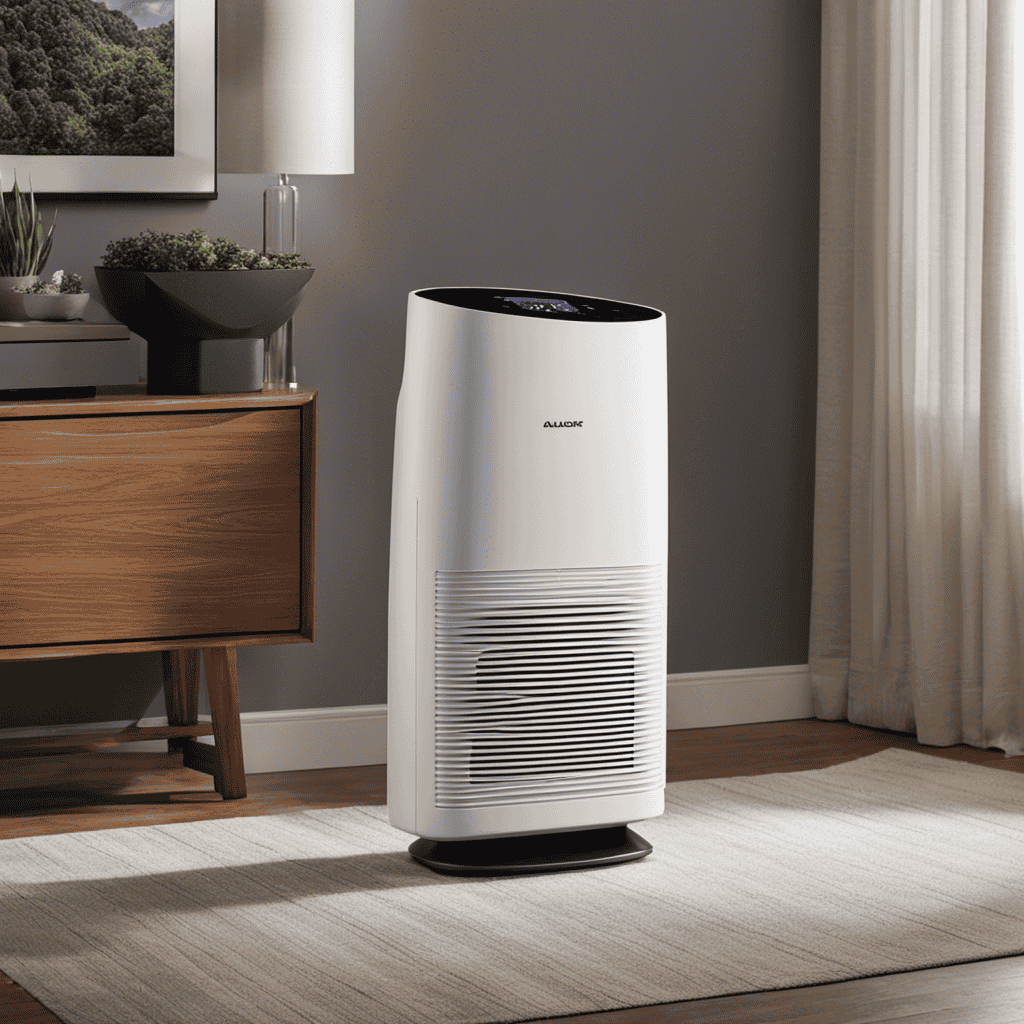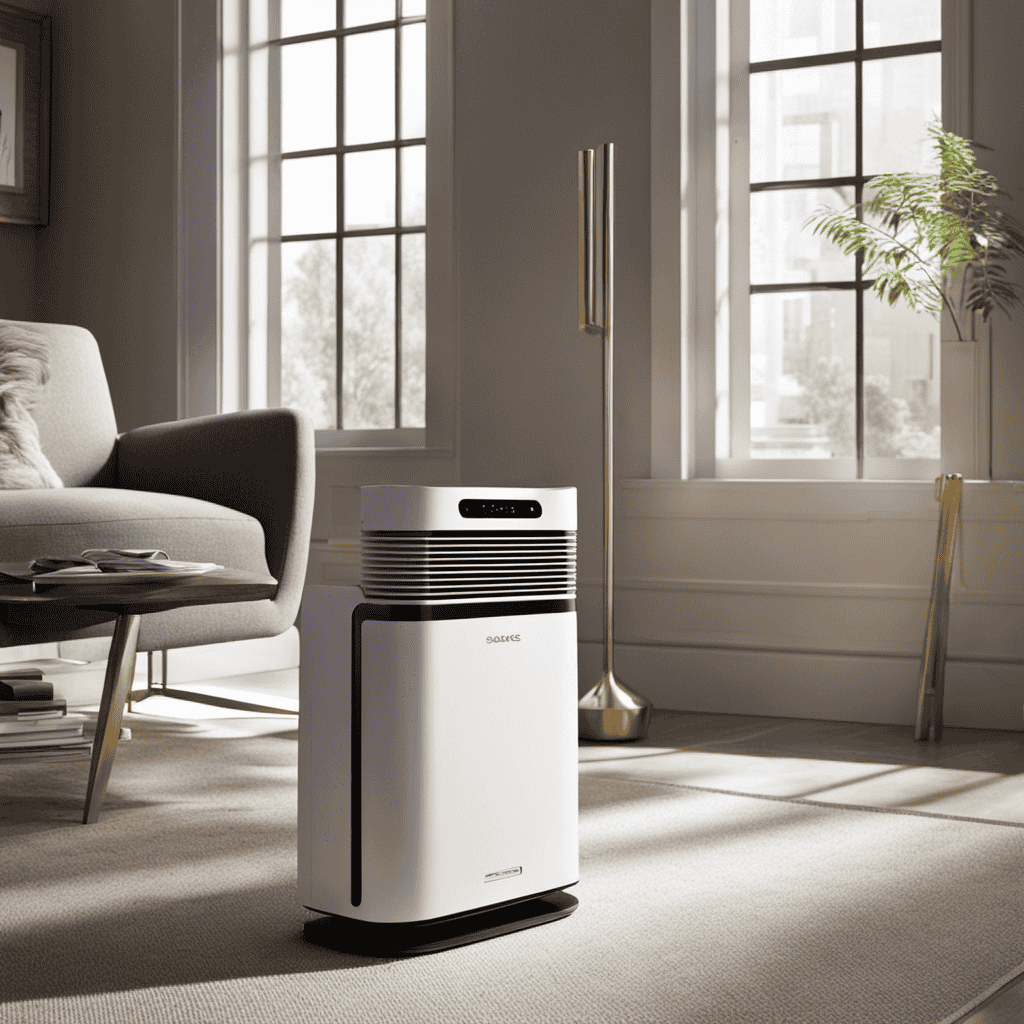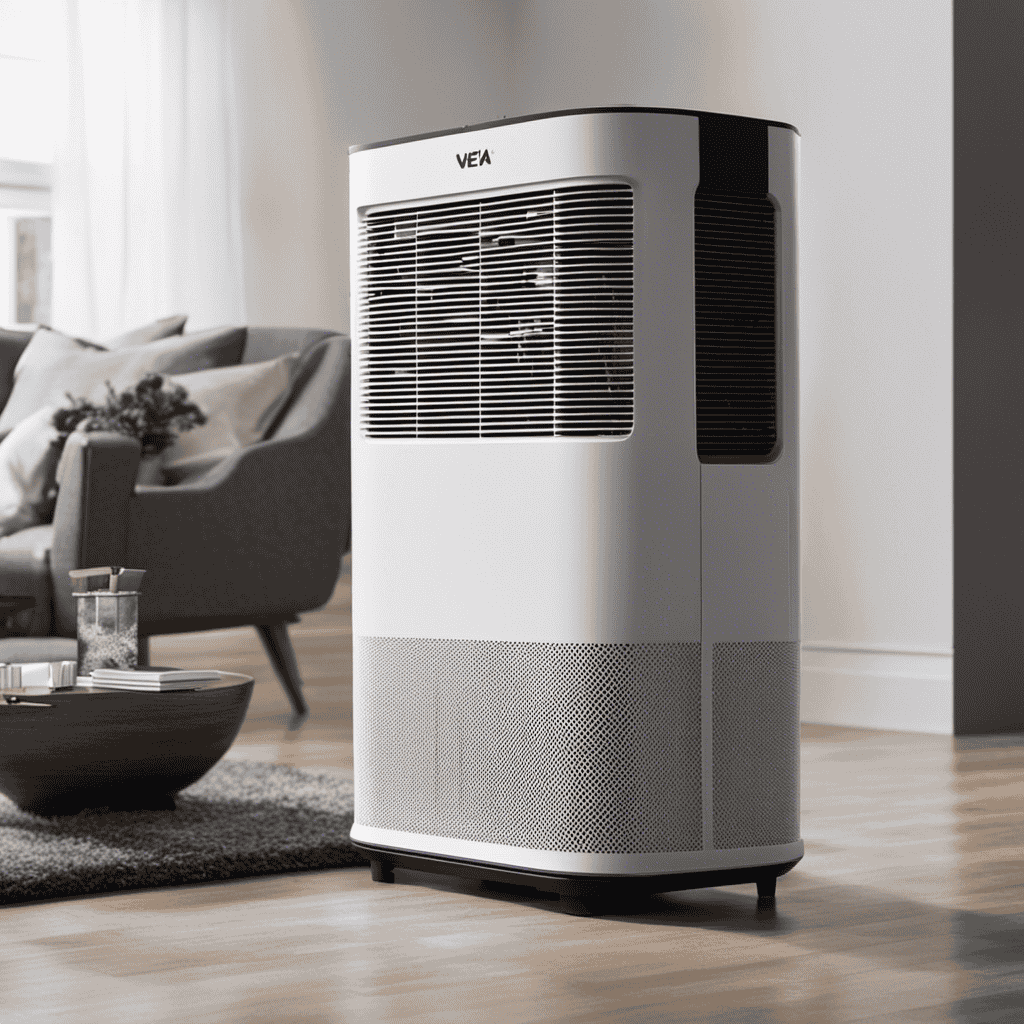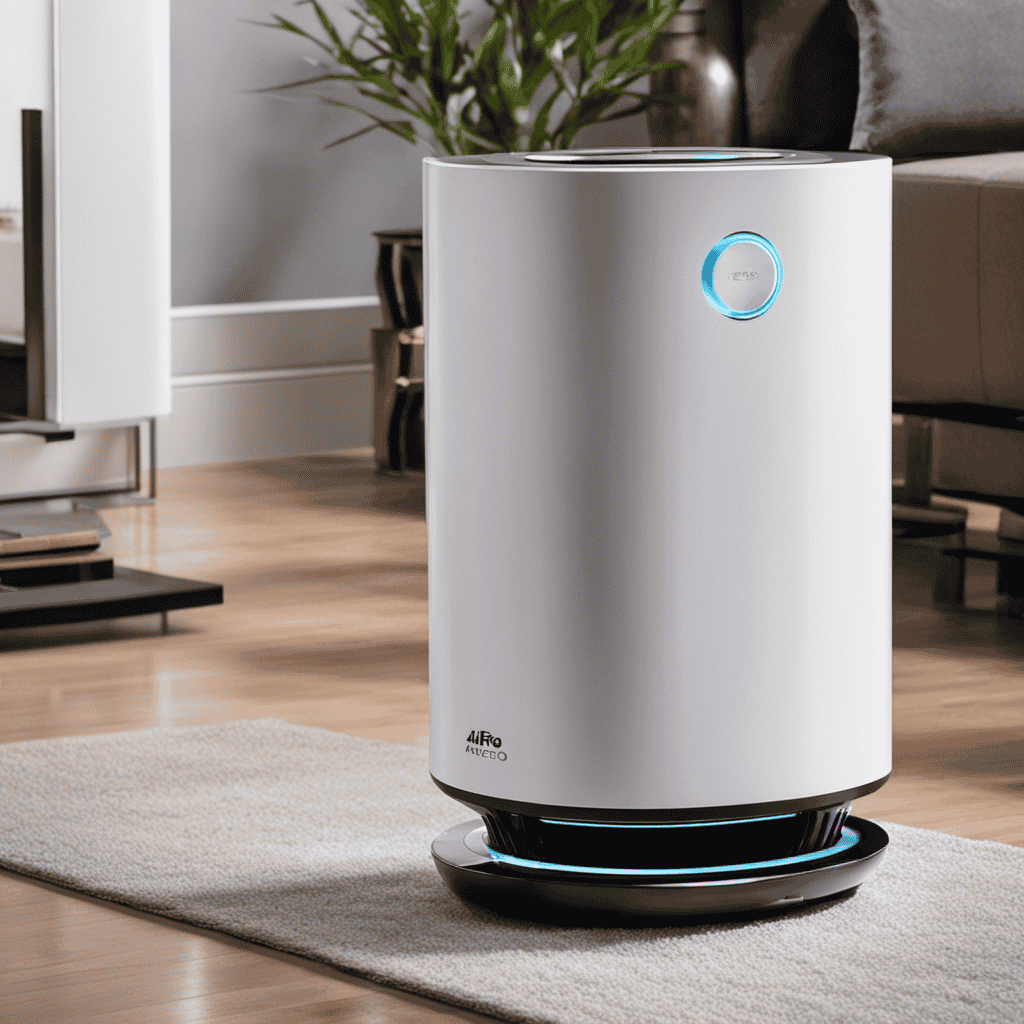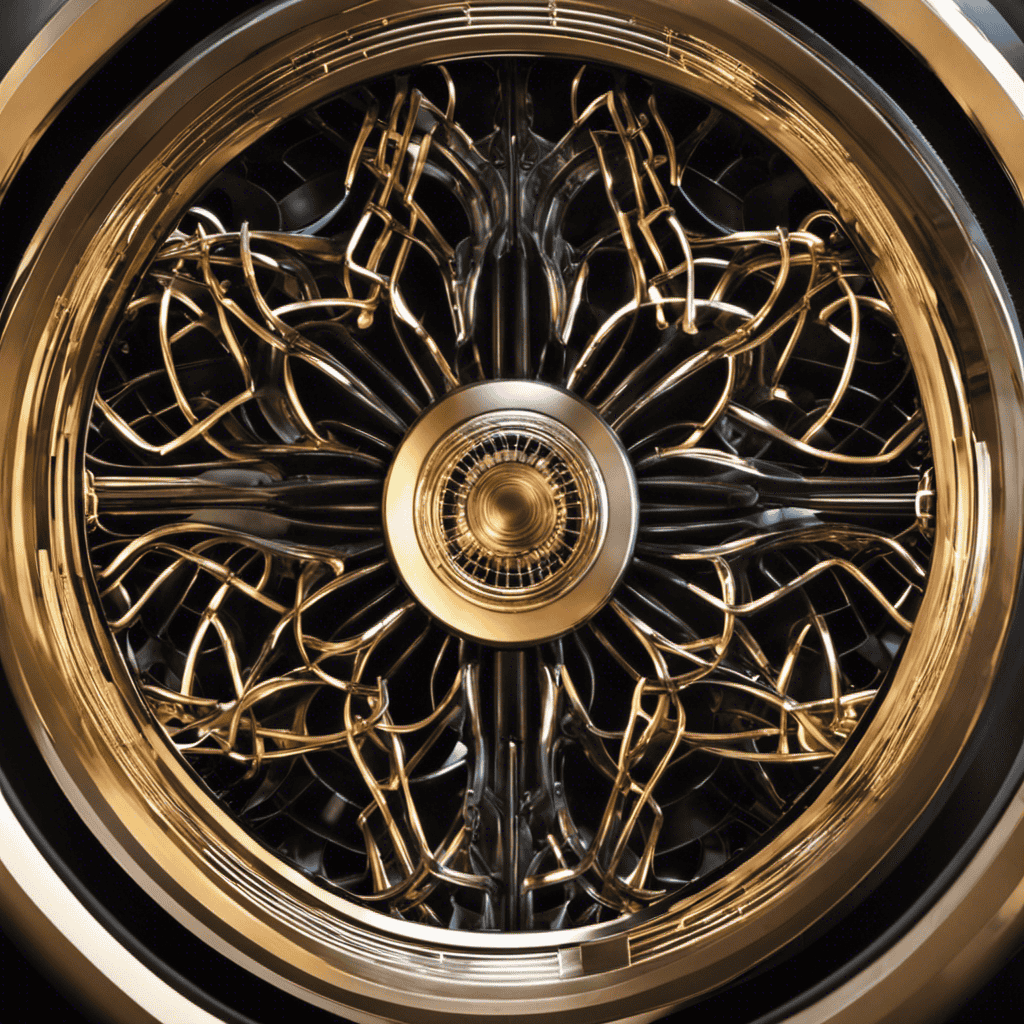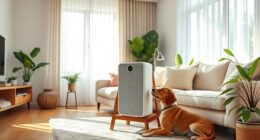When it comes to breathing in clean, fresh air, the saying ‘you are what you breathe’ holds true. That’s why it’s crucial to find the perfect air purifier.
In this article, I’ll guide you through the important factors to consider when buying an air purifier. From the types of purifiers available to the coverage area, filtration system, and even noise level, I’ll provide you with the knowledge and information you need to make an informed decision.
So, let’s dive in and breathe easier!
Key Takeaways
- Consider the coverage area of the air purifier to ensure it matches the size of the room.
- Look for air purifiers with effective filtration systems such as HEPA filters and activated carbon filters.
- Choose an air purifier with a CADR rating that matches the room size for effective air purification.
- Take into account the noise level and energy efficiency of the air purifier, especially for placement in bedrooms or offices.
Types of Air Purifiers
There are three main types of air purifiers: HEPA filters, activated carbon filters, and ozone generators. Each type utilizes different purification technologies to enhance indoor air quality.
HEPA filters are highly effective in removing airborne particles such as dust, pollen, and pet dander. They work by trapping these particles in a dense filter material.
Activated carbon filters, on the other hand, are excellent at eliminating odors and chemicals. They contain a porous material that absorbs and traps these impurities.
Ozone generators work by releasing ozone molecules into the air, which can neutralize odors and kill bacteria. It is important to note that ozone generators should be used with caution, as high levels of ozone can be harmful to humans.
Some air purifiers also come with air quality sensors, which monitor the air and adjust the purification settings accordingly.
Now that we understand the different types of air purifiers and their purification technologies, let’s move on to the next section about the coverage area.
Coverage Area
When determining which air purifier to purchase, it’s important to consider the coverage area. The ideal room size for an air purifier depends on the air quality standards you want to achieve.
To ensure effective air purification, it’s crucial to choose an air purifier that can handle the size of your room. Most air purifiers specify the maximum square footage they can effectively cover. For example, if you have a large living room, you’ll need an air purifier with a higher coverage area. On the other hand, if you’re looking to purify a small bedroom, a purifier with a lower coverage area will suffice.
Understanding the ideal room size for your air purifier will help you achieve optimal air quality and ensure that your air purifier performs efficiently.
Filtration System
To ensure optimal filtration, you should consider the type of filtration system used in the air purifier you’re considering. There are several types of filtration systems available, each with its own advantages and limitations.
Here are some key points to keep in mind:
-
HEPA filters: Highly effective at removing particles as small as 0.3 microns, including dust, pollen, pet dander, and mold spores.
-
Activated carbon filters: Excellent for removing odors, gases, and volatile organic compounds (VOCs).
-
Air quality measurements: Some air purifiers come with built-in sensors that monitor and display real-time air quality measurements, such as PM2.5 levels, temperature, and humidity.
-
Noise levels: Consider the noise level of the filtration system, especially if you plan on using the air purifier in your bedroom or office.
-
Maintenance: Check if the filters are easy to replace and how often they need to be changed.
-
Energy efficiency: Look for an air purifier with an Energy Star rating to ensure it operates efficiently and saves energy.
Considering these factors will help you choose an air purifier with a filtration system that meets your specific needs and ensures cleaner and healthier indoor air.
CADR Rating
The CADR rating indicates how quickly the air purifier can remove pollutants from the air in a specific-sized room. It is an important factor to consider when buying an air purifier as it directly affects the effectiveness of the device.
CADR stands for Clean Air Delivery Rate and is measured in cubic feet per minute (CFM). The higher the CADR rating, the faster the air purifier can filter the air in a room.
When choosing an air purifier, it is recommended to look for a CADR rating that matches the size of the room you intend to use it in. This ensures that the air purifier will effectively clean the air and provide you with clean, fresh air to breathe.
Noise Level
You should consider the noise level of an air purifier before making a purchase. When it comes to silent operation, different air purifiers have different decibel levels. Here are some things to keep in mind:
-
Placement: Consider where you plan to place the air purifier. If it’s going to be in your bedroom or office, you’ll want one with a low decibel level to avoid disturbing your sleep or work.
-
Modes: Look for air purifiers that offer different modes, such as a silent or sleep mode. These modes reduce the fan speed and noise level, ensuring a peaceful environment.
-
Real-life reviews: Read reviews from other customers to get an idea of how quiet the air purifier actually is. Sometimes, the decibel levels mentioned by the manufacturer may not reflect the actual noise level in real-life situations.
Energy Efficiency
Consider researching the energy efficiency of different models before making a decision.
When it comes to air purifiers, energy efficiency plays a crucial role in both environmental conservation and cost savings. Look for models that utilize smart technology, which can automatically adjust the fan speed and power consumption based on the air quality in your home. This not only ensures that the purifier operates at optimal efficiency but also saves you money on energy bills.
Additionally, opt for units with user-friendly controls that allow you to easily customize and monitor settings. These controls may include features such as programmable timers, filter replacement indicators, and air quality sensors.
Maintenance and Filter Replacement
After considering the energy efficiency of an air purifier, it’s important to understand the maintenance and filter replacement requirements. Proper maintenance ensures the longevity and effectiveness of your air purifier. Here are some maintenance tips to keep in mind:
- Regularly clean the pre-filter to remove larger particles and extend the lifespan of the main filter.
- Follow the manufacturer’s guidelines for filter replacement. Filters typically need to be replaced every 6 to 12 months, depending on usage and air quality.
By properly maintaining your air purifier and replacing filters when necessary, you can ensure that it continues to provide clean and fresh air in your space.
Now, let’s move on to the next section about the size and design considerations when buying an air purifier.
Size and Design
When it comes to choosing an air purifier, there are several important factors to consider.
First and foremost, you need to determine the ideal room coverage for the purifier. This will ensure that it effectively cleans the air in your space.
Additionally, aesthetics and functionality are crucial aspects to think about. You want a purifier that not only fits in with your room’s decor but also provides convenient and user-friendly features.
Ideal Room Coverage
To determine the ideal room coverage for an air purifier, you’ll want to calculate the square footage of the space you want to purify. This will help you choose the right size purifier that can effectively clean the air in your room.
When considering the ideal room size for an air purifier, keep in mind the air exchange rate, which refers to how quickly the purifier can cycle the air in the room. Here are a couple of things to consider:
- The size of the room: Larger rooms require a purifier with a higher air exchange rate to effectively clean the air.
- The level of air pollution: If your room is subject to high levels of pollution, such as from smoke or allergens, you may want to choose a purifier with a higher air exchange rate to keep the air clean and fresh.
Aesthetics and Functionality
One important factor to consider is whether the purifier blends well with your existing decor. Choosing an air purifier that not only effectively cleans the air but also complements your home’s aesthetic is essential.
When it comes to air purifier placement, it’s important to choose a location where the purifier can effectively circulate the air in the room. Placing it near sources of pollutants, such as near a window or an air vent, can help improve its effectiveness. Additionally, avoid placing the purifier in a corner or behind furniture, as it may hinder the airflow and reduce its performance.
Digital Controls and Features
If you’re considering buying an air purifier, make sure you check out the digital controls and features. These innovative gadgets are equipped with smart technology that enhances their functionality and convenience.
Here are some key features to look for:
-
Smart Technology:
-
Wi-Fi Connectivity: Allows you to control and monitor your air purifier remotely through a smartphone app.
-
Voice Control: Compatible with virtual assistants like Alexa or Google Assistant for hands-free operation.
-
Air Quality Sensors:
-
Particle Sensor: Detects and measures the levels of pollutants in the air, providing real-time feedback and adjusting the purification settings accordingly.
-
Odor Sensor: Identifies and eliminates odors, ensuring fresh and clean air at all times.
Investing in an air purifier with these digital controls and features will not only improve your indoor air quality but also provide a seamless and effortless experience.
Portability and Mobility
When considering portability and mobility, you’ll appreciate the compact size and lightweight design of this air purifier. It is designed with portability features that make it easy to move around your home or take with you on the go. The compact size allows for easy placement in any room, and the lightweight design makes it effortless to carry from one location to another. Whether you want to use it in your bedroom, living room, or even in your office, this air purifier offers convenience and ease of movement.
| Portability Features | Ease of Movement | Compact Size |
|---|---|---|
| Built-in handle | 360-degree wheels | Space-saving |
| Lightweight | Cord storage | Portable |
| Carry bag included | Flexible placement | Travel-friendly |
With its built-in handle and 360-degree wheels, you can easily transport this air purifier from room to room without any hassle. It also comes with a carry bag for added convenience when you want to take it with you on trips. The cord storage feature ensures that you can neatly store the power cord when not in use, keeping everything organized. Additionally, the compact size and flexible placement options allow you to fit this air purifier in small spaces, making it ideal for apartments or offices with limited room. Overall, the portability features and ease of movement make this air purifier a practical choice for those who value convenience and versatility.
Price Range
To find an air purifier within your desired price range, you can compare different models and brands to see which one offers the best value for your budget. Conducting a price comparison will help you make an informed decision and ensure you get the most bang for your buck.
When considering budget options, keep in mind the following:
-
Features: Look for air purifiers that offer essential features like multiple fan speeds, a HEPA filter, and a timer.
-
Maintenance: Consider the cost of replacement filters and how frequently they need to be changed.
By comparing prices and features, you can find an air purifier that suits both your needs and your budget.
Once you’ve narrowed down your options, it’s important to consider the brand reputation and customer reviews to ensure you’re investing in a reliable and effective product.
Brand Reputation and Customer Reviews
You should consider brand reputation and customer reviews before making a final decision.
When it comes to buying an air purifier, customer satisfaction and brand reliability are key factors to consider.
A reputable brand with positive customer reviews indicates that the product is likely to be reliable and effective.
Before making a purchase, take the time to research different brands and read customer reviews to get an idea of their experiences with the air purifier.
Look for common themes such as improved air quality, reduced allergies, and ease of use.
Positive reviews and high customer satisfaction indicate that the brand and its products can be trusted to deliver the desired results.
Don’t underestimate the value of customer feedback when it comes to making an informed decision about an air purifier.
Warranty and Support
When it comes to purchasing an air purifier, it’s important to consider the warranty and support offered by the manufacturer. A good warranty can provide peace of mind and ensure that you are protected from any unexpected issues that may arise with your air purifier. Additionally, having access to reliable support can be invaluable in case you encounter any problems or have questions about your device.
Here are some troubleshooting tips to keep in mind:
- Make sure the air purifier is properly plugged in and turned on.
- Clean or replace the filters regularly to maintain optimal performance.
- Check for any obstructions or blockages that may be hindering airflow.
By following these tips and taking advantage of the warranty and support offered by the manufacturer, you can ensure customer satisfaction and get the most out of your air purifier.
Now let’s move on to the next section, where we will discuss ozone emissions.
Ozone Emissions
If you’re concerned about ozone emissions, it’s important to choose an air purifier that is certified as ozone-free. Ozone pollution can have detrimental effects on our health, causing respiratory issues, lung damage, and even aggravating existing conditions such as asthma and allergies. By opting for an air purifier that does not emit ozone, you can ensure that the air you breathe is clean and safe.
Look for models that are certified by reputable organizations, such as the Asthma and Allergy Foundation of America (AAFA) or the California Air Resources Board (CARB). These certifications guarantee that the air purifier has undergone rigorous testing to ensure its ozone-free status. By prioritizing ozone-free air purifiers, you can effectively protect yourself and your loved ones from the harmful effects of ozone pollution.
Now, let’s move on to discussing additional accessories and features that you should consider when buying an air purifier.
Additional Accessories and Features
Now that we’ve covered ozone emissions, let’s explore some additional accessories and features to consider when buying an air purifier.
Here are some advanced features and accessories that can enhance your air purifier experience:
-
Filter Replacement Indicator: This feature notifies you when it’s time to replace the filters, ensuring that your air purifier continues to effectively clean the air in your space.
-
Smart Connectivity: Some air purifiers come with Wi-Fi compatibility, allowing you to control and monitor your device remotely using a smartphone app. This enables you to adjust settings and receive real-time air quality updates even when you’re not at home.
-
Voice Control: Certain models also offer voice control compatibility with virtual assistants like Amazon Alexa or Google Assistant, making it even more convenient to operate your air purifier hands-free.
How Does the Size of an Air Purifier Affect What to Look for When Buying One?
When choosing the right air purifier size, consider the square footage of the room where it will be used. Larger rooms require a higher CADR (clean air delivery rate) to effectively clean the air. Look for air purifiers specifically designed for the size of the room you want to purify.
Frequently Asked Questions
How Does an Air Purifier Affect the Indoor Air Quality?
An air purifier can greatly improve indoor air quality by effectively removing pollutants and allergens. It benefits by reducing the risk of respiratory issues and promoting a healthier living environment.
Can an Air Purifier Remove Pet Dander and Allergens?
Yes, an air purifier can remove pet dander and allergens. It’s crucial to consider the maintenance required for optimal effectiveness. Regular cleaning and filter replacements ensure the air purifier continues to do its job effectively.
What Is the Difference Between a HEPA Filter and an Activated Carbon Filter?
A HEPA filter is designed to capture small particles like pollen and pet dander, while an activated carbon filter helps remove odors and harmful gases. Both filters work together to provide cleaner and fresher air in your home.
Are There Any Health Risks Associated With Using an Air Purifier?
There can be health risks associated with using an air purifier, but the benefits outweigh them. It’s important to choose a purifier that filters out harmful particles and doesn’t produce ozone.
Can an Air Purifier Eliminate Odors From Cooking or Smoking?
Yes, an air purifier can effectively eliminate odors from cooking or smoking. Regular air purifier maintenance, such as replacing filters, ensures optimal performance. Additionally, using an air purifier in the bedroom offers various benefits, such as improved air quality and better sleep.
Conclusion
After considering all the important factors, it’s clear that buying an air purifier can be a breath of fresh air for your home.
With various types to choose from, make sure to select the one that matches your needs. Pay attention to the coverage area, filtration system, and CADR rating to ensure optimal performance.
Don’t forget to check the noise level and brand reputation, as they can make or break your experience. And remember, like a cherry on top, look for additional accessories and features to enhance your air purifying journey.
Happy purifying!
